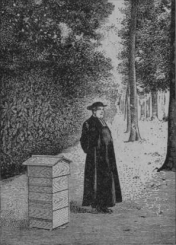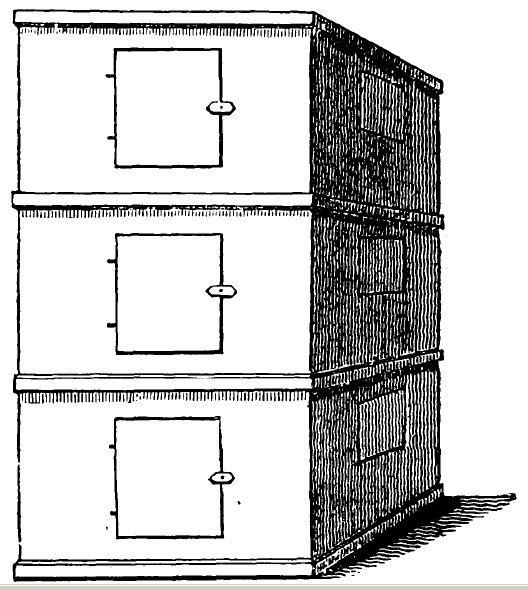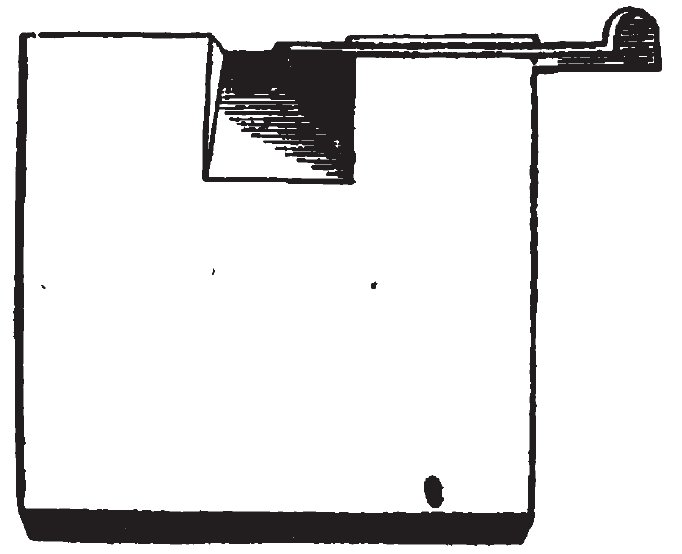
Warré plans
Warré methods
Warré modifications
Warré precursors
Groups / Fora
Google
e-group
Biobees.com
forum
Abbé Warré's book
Beekeeping for All:
In his book The honey bee; its natural history, physiology, and management1 published in 1827, the physician and well known apiarist, Edward Bevan (1770-1860), described a vertical or 'storified' top-bar hive concept almost identical to the 'People's Hive' of Abbé Emile Warré.

The content of this page is taken from Chapter 7 'Bee Boxes' of the first or American editions, Chapter 12 (Storifying) of the first edition and Chapters 10, 11 and 18 of the American edition1.
The hive body box is 305 x 305 mm square (1st edition) or 297 x 297 mm (American edition) and 229 mm high. These dimensions are specified as 'in the clear', i.e. internal measurements. Each box has a window at the back and one in each side, all three set in narrow rebates. The side windows are added because the back window is not wide enough to permit viewing of the side combs. (The Frèrès/Guillaume modification of the Warré hive is also glazed, only the window, situated in the back, spans the full width of the box.) Bevan advises making the walls 25 mm thick. The top rims front and back are rebated half their width to receive the top-bars.
The first edition of Bevan's book specifies 6 top-bars 19 mm thick and 38 mm wide, leaving about 13 mm space between each. The American edition specifies 7 top-bars 13 x 29 mm. Of these, he advises placing the three centre bars 11 mm apart and gradually increasing the spacing to 14 mm apart at the sides. This is to accommodate the tendency for comb to be narrower in the central brood area compared to the peripheral honey area.
There is a 'close cover' 25 mm thick on top that is screwed down with four screws in lubricated holes. This clamping he sees as essential to counter warping as 'a considerable quantity of steam rises from the bees in some seasons'.
The loose floor is 25 mm thick and extends 38 mm beyond the back and sides of the boxes. Although the entrance can be cut in the lower rims of the fronts of the boxes, he finds it more convenient to cut the entrance in the floor. The slot is 13 mm (half the thickness of the board) at the outermost edge and slopes upwards towards the middle, thus providing a ramp for the bees to ascend and allowing driving rain to drain outwards. The width of the slot is 102 mm. The Bevan floor is almost identical to a Warré floor (see the Bevan floor image below).
 .
.
The floor has a slot cut in it to receive a sliding closer.
Between each box is a board, which he variously calls a 'centre board' or a 'middle board', which 'give[s] a more finished appearance to the pile'. It's function is otherwise obscure. It is the same size and thickness as the floor and is fitted with bars to align with those of the box underneath, except that these bars are 3 mm narrower to allow for inaccuracy of alignment. The ends of this board are ploughed and tongued to prevent warping.
The hive as described so far has no weather protection, so is designed for use in a bee house. If the hive is under the cover of an open shed, Bevan advises making the top and sides of the boxes somewhat thicker. Alternatively, if thinner wood is used he recommends covering the hive with a secondary wall and roof of, for example, wood from China tea chests. The cavity can be filled with sawdust etc.
He suggests making the front and back walls 13 mm thicker at the bottom on the inside to stop heavy combs coming adrift in hot weather. This inclined inner wall is reminiscent of modern horizontal-format top-bar hives.
Before populating the hive he advises fusing guide combs to the top bars. These can be as small as 50 mm in diameter.
As the illustration indicates, Bevan's is a storified hive. To expand it he advises supering (adding a box on top) existing stocks but nadiring (adding a box underneath) developing swarms (Chap. 18, American edition). For supering and nadiring, Bevan describes the use of dividers which are copper or brass plates 1.5 mm thick and about 380 mm square with one edge folded up about 13 mm to enable it to be gripped easily. The dividers are to keep the bees in the hive during the manipulations. In supering, the divider is first slid under the top board, the board is removed, the super placed in position with the board on top and the divider removed. For nadiring, two dividers are inserted on the floor under the bottom box. The hive is lifted aside with one divider held in place under it. The nadir with its middle board are quickly placed on the floor, the set aside boxes returned and the dividers slid out. He adds that it is better not to use dividers as they annoy the bees.
Reference
1. Edward Bevan The honey bee; its natural history, physiology, and management.. London, Baldwin, Cradock, and Joy, 1827. xxvi, 404 p. illus., plates. 20 cm. The second edition was published in 1838 and the American edition in 1843. Download the first edition at http://apicultura.wikia.com/wiki/Edward_Bevan . Download the American edition .
Other resources:
The honey bee; its natural history, physiology, and management
(1827)
http://archive.org/details/honeybeeitsnatur00bevarich
http://archive.org/details/honeybeeitsnatur00beva
Hints on the history and management of the honey bee: Being the
substance of two lectures read before the members of the Hereford Literary, Philosophical
and Antiquarian Institution in the winter of 1850-51 (1851)
http://archive.org/details/hintsonhistorya00bevagoog
Acknowledgement
We thank Steve Ham for drawing our attention to this work, and Phil Westwood for supplying the additional resources.